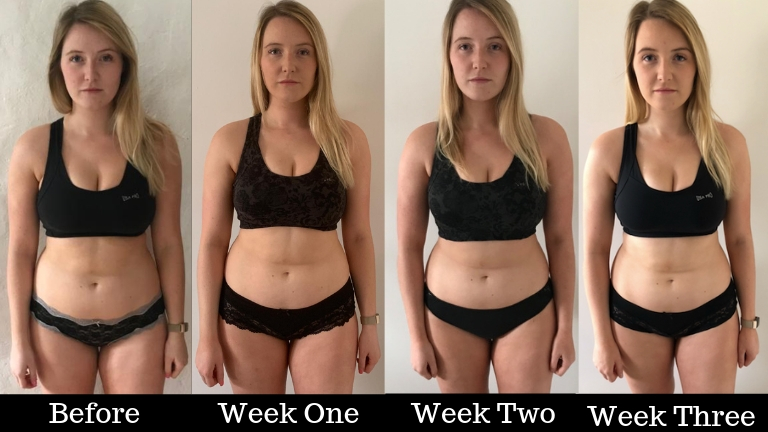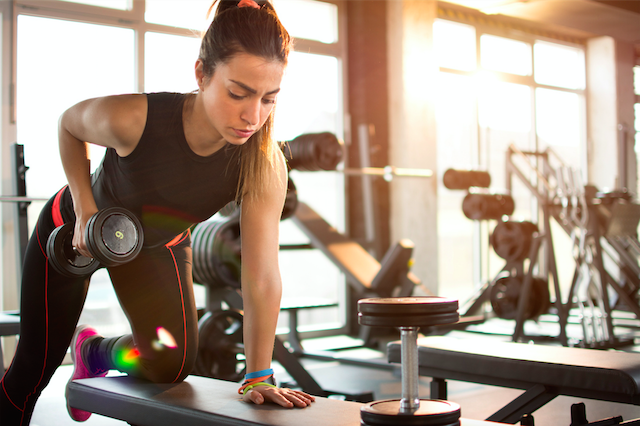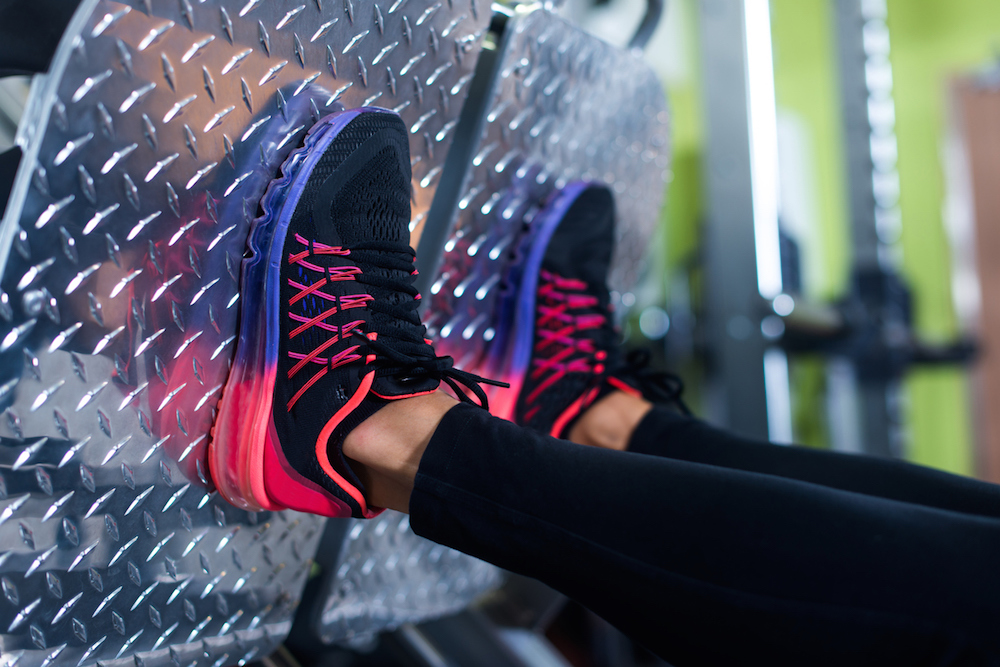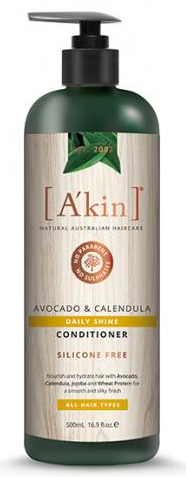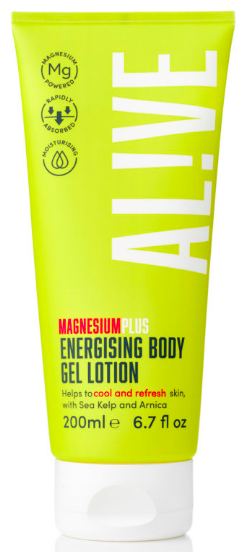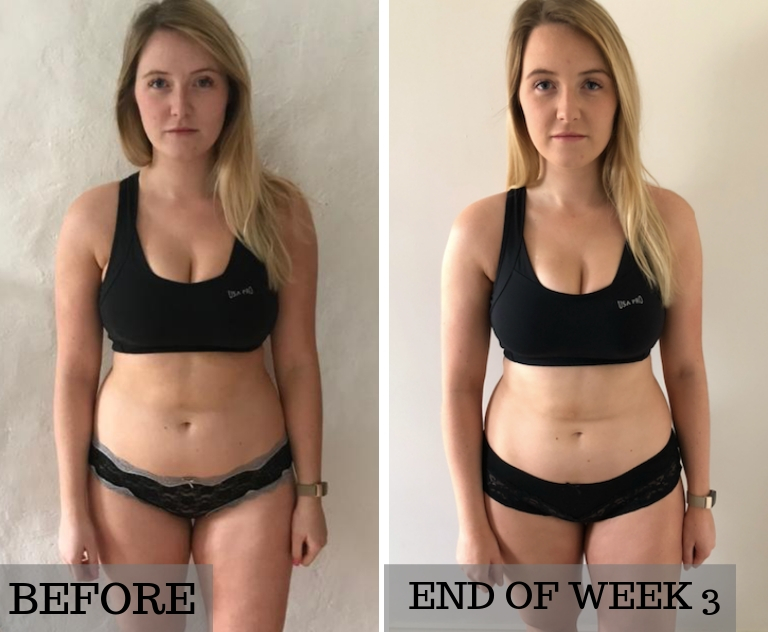It’s week 3 of Olivia Robbins’ body transformation at Transition Zone and she has lost over three kilos and 11 inches! Here are her steal-able lessons about how to get results from the gym
So week two went surprisingly well (you can read more about that here) – I lost 2.8 per cent body fat and 2.6kgs, in just two weeks. Obviously, I hope I can keep this going throughout week three.
I’ll be honest, I am quietly confident in myself now that I realise this weight loss thing is possible and is actually working. I am taking this transformation seriously and making sure I stay consistent with both my eating and training. Consistency is key according to my trainer, Transition Zone’s Mark Stanton (@insidetrack_pt) and nutritionist Emma Bardwell who are helping me through this transformation.
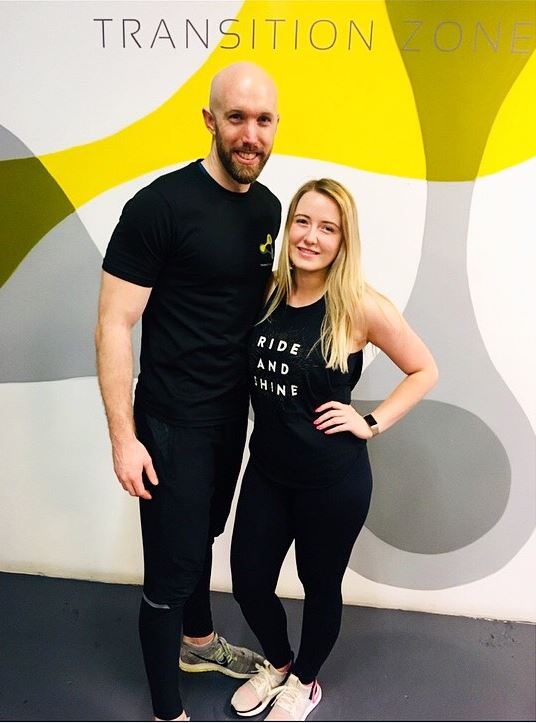
I am also far more confident during my training sessions now. Although, Mark has had to have words with me for constantly saying, ‘I can’t do it’ to which he replies ‘but you are doing it’.
So, apart from me being a negative Nancy 50 per cent of the time, I now know that I can lift heavier than I thought I could without falling over or dropping the weight on my head.
The realisation that I can actually train properly and use the equipment correctly has reminded me of the time when I would walk into the gym, have a look around, clock where the empty machines were and jump on the one that obscured me most from the view of everyone else. How sad, poor Olivia. What a waste of my time, eh?
I mentioned in week one, that one of the main things I wanted to get out of this transformation was to actually learn how to exercise properly and confidently. I no longer wanted to envy the people using the squat rack and free weights, looking not only amazing but like they really know what they’re doing.
So, this week I want to focus on progression and confidence in the gym, and letting go of ‘gymhibitions’. If you are one of those people who is unconfident and unsure when walking into the gym then these tips should help ease your worries.
#1 Keep a workout diary (aka have a plan)
If you have a personal trainer (or a Mark Stanton, in my case), they’ll be the one helping and making a plan with you.
But for those who don’t have the luxury of a personal trainer, make sure you are prepared and have a plan on what you want to do when you get to the gym. Ideally the programme should include some timings and deadlines to work towards.
‘While a long term plan is hugely important with goals and targets to aim towards, having even just one session plan before you walk into the gym will help improve your confidence greatly,’ explains Mark.
‘Likewise another tip is to record your gym sessions in your diary at the start of each week, as this will allow you to plan around them and subconsciously lead to you being more likely to go to the gym’.
By having a plan, you won’t walk in to the gym and be overwhelmed with all the options and equipment around you. It will also help to squash the sense of dread that I have felt only too often – the ‘I don’t even know where to start’ thoughts.
By having a plan, you won’t walk in to the gym and be overwhelmed with all the options and equipment
Nowadays, it is easier than ever to educate yourself and get ideas about workouts from platforms such as Instagram and YouTube.
YouTube is literally full of ideas to help you plan a workout. Take Healthista’s YouTube channel for example, we have squat challenges, ab challenges, pilates workouts, barbell workouts, dumbbell workouts or better yet our ‘How To – 25 gym moves in 25 days’ videos. And that’s just our channel, there are thousands of videos to help inspire your workout.
Although YouTube is great for inspiration and motivation, it would probably be a good idea to have one or two sessions with a good personal trainer first. They can help you make a plan and provide you with some good exercises that you can practice and execute properly.
So next time you go to the gym, don’t just walk over to the treadmill, plan a workout on YouTube or with a personal trainer, write it down and stick with it.
#2 Fake confidence
This is a simple suggestion. Thing is, even if you feel super unconfident and nervous about being in the gym, is anyone going to notice? Probably not, unless you stand there crying, of course.
Not that anyone will even be paying attention, but if you act like you know what you’re doing (even if you don’t) the last thing anyone is going to think is that you have no idea what you are doing. Acting confident is a lesson for life says Mark, ‘Repetition leads to habit, even with confidence’.
Plus, by faking confidence you will probably end up being more confident. So don’t be shy and don’t worry about the serious looking guy who looks like he could chest press a car, he’s probably just thinking about dinner…(chicken breast obv.)
#3 Warm up properly
Before I started at Transition Zone I had no idea how to warm up properly, apart from when they used to make me run around a track five times at school and call it a warm up. Turns out warming up is actually quite necessary.
And, it doesn’t just mean feeling a bit warm and out of breath, it actually involves dynamic stretching, and core work. Dynamic stretches are stretches that involve constant movement and don’t require holding a position like most other stretches that our known. Therefore, a dynamic stretch is opposite to a static stretch, here’s a video for you:
This particular type of stretching helps to activate muscles, increases your range of movement, boosts oxygen and blood flow, improves flexibility, provides energy to the muscles and in turn preps your body before a workout to help prevent injury, especially if you’re about to lift weights.
Learning how to stretch properly is important as it will reduce your risk of injury and quicken muscle recovery, whilst also improving your flexibility and posture.
Transition Zone have an excellent warm up routine that really does cover all bases that includes dynamic stretches such as squats, lunges and lizards. These stretches are about muscle activation, which is either aimed at improving postural issues or ‘switching on’ relevant muscles such as the core and glutes for the session ahead. Also integration, putting the newly activated muscles into a relevant compound movement to the session such as goblet squats.
https://www.instagram.com/p/ByGb1C8Hvxf/
So, my point – next time you go to the gym, do not just start running or start lifting the weights. Spend the first ten minutes warming up with some dynamic stretches.
#4 Use the free weights – they work
The weight machines at the gym look impressive but also a bit scary, and to be honest it can take more time to set them up than you actually spend working out on them. You make sure the seat is the right height, that all other adjustments are in the right place, then selecting the weight – what a faff.
Take the leg press machine for example. It looks quite impressive, right? But if you are nervous about using the gym machines or there is someone on it then just use the free weights to squat with instead (see below). Or if you’re brave enough, ask someone or ask a member of staff what to do, it’s unlikely they will say no.
Know what a split squat is? If you do then you know that they BURN – they’re basically static lunges with your front or back leg elevated. Split squats seriously work the legs and all you need to do is hold some dumbbells or kettle bells in either hand. No messing around on a machine, just you, two dumbbells/kettle bells and an exercise that will seriously BURN. Job done.
#5 Don’t do the same things every time – progress is everything
Another term that has been permanently etched into my brain thanks to Mark is ‘progression’. By this, Mark means that every session will become a bit more of a challenge.
Progression basically means adding more weight or doing more reps of each exercise when what you were doing feels easier – actually you really should be adding more weight or reps regularly, however it’s feeling. For example, in my very first session I lifted a total of 928kg and in my most recent session (see below workout), 1564kg. See – progression.
‘One simple way to measure progress when resistance training is to calculate training volume,’ explains Mark. Training volume is calculated by:
Exercise one – (weight x reps) x sets + exercise two – (weight x reps) x sets + exercise three ( weight x reps) x sets and so on.
Eg: Exercise one – Goblet squats 20kg x 10 reps = 200kg x 3 sets = 600kg + Exercise two – Chest press 10kg x 10 reps = 100kg x 3 sets = 300kg. Total = 900kg (sounds impressive right?)
‘This is useful as it tracks your progress but also highlights how small changes in weights or reps can make a huge difference in overall session load and therefore your fatigue,’ says Mark.
‘Take the same session above but add two reps to each set of chest presses and 5kg to your squats and…
25kg x 10 x 3 = 750kg + 12kg x 12 x 3 = 432kg. Total = 1182kg per session.
When people get comfortable and confident with something they tend to stick with it, it’s a natural thing us humans like to do. We love routine and we enjoy doing things we are good at. If you go to the gym and do a really good workout, you are likely to repeat that workout because you know you can do it. This is what I used to do back at university – I’m sure I’m not alone on this one?
Anyway, the body actually responds better when we challenge ourselves. So if you know you can squat 15kg and you aren’t struggling or out of breath afterwards, try increasing the weight. Don’t just stick to 15kg just because you know you can do it, challenge yourself. It’s the same with bodyweight exercises. If you know you can hold a plank for two minutes, next time aim for two minutes, 30 seconds.
Week three: the workout
So as I mentioned in week one, for the first three weeks, Mark focused our training on developing movement patterns and improving my muscles’ capacity to work. So, that basically means getting me used to lifting weights, and showing me I can do it. ‘It also increases the muscles’ endurance or robustness and means we are less likely to get injured,’ explains Mark.
It’s week three now though, so Mark has slowly been increasing the amount of weight for each session. To achieve fat loss, we have been doing compound movements in upper and lower body supersets.
Compound movements are important because they work several muscles or muscle groups at one time. For example, a squat uses a number of muscles in the core, lower back and lower body including the quadriceps, hamstrings, calves and glutes.
Mark has slowly been increasing the amount of weight each session
Deadlifts and even push ups are compound movements for the same reason, they use a number of muscles and as a result burn more calories. That’s as opposed to say, a bicep curl which is an ‘isolated movement’ that burns far fewer calories and induces fewer chemical responses in the body. ‘Plus if you worked out every muscle individually it would take forever,’ says Mark.
A superset refers to two exercises performed back-to-back, with little or no rest in between. This can help to cut your workout time in half as you’re only resting once you have finished two moves.
Mark says that, ‘supersets are basically doing two sets of exercises back to back, it does not matter if they are the same, opposite or completely separate muscle groups, depending on what your goals are. It also adds in a more aerobic aspect to training as you are working longer before resting’.
Workout of the week:
Week three consisted of three weight training sessions with Mark that lasted 60 minutes on Monday, Wednesday and Thursday mornings. Here was my favourite (but killer) session:
Upper body/ lower body super-set: 3 sets each exercise
Lower body: Deadlift – 10 reps, 32kg kettle bell
Notes: Down for three counts, pause slightly on count three and then ‘snap’ back up.
Upper body: Press ups – 10 reps (use the squat rack to add an incline, drop the bar to make it harder)
Notes: Breathe in when pressing chest down, breathe out when pushing up.
Upper body/ lower body super-set: 2 sets each exercise
Lower body: Split squat – 10 reps, bodyweight (I was still feeling the previous days training – ouch)
Note: make sure you are looking at down at the foot in front of you, that you can still see your toes and your knee is not over them.
Upper body: Single arm dumbbell row – 10 reps, 12kg
Note: keep your chin down so your back and neck are all in line. Keep elbows tucked in and pinch shoulder as much as possible at the top.
Lower body/ core super-set: 2 sets each exercise
Core: Palov press with resistance band – 10 reps
Notes: make sure you ‘brace your core’
Lower body: Glute raise and hold – 10 reps, 5kg
Notes: again make sure your core is tight
Cardio
Sled push and pull x5, 50kg
Note: my only note is breathe and good luck…
Make sure to stretch properly after your workout. Hold your stretches for a minimum of 15 seconds.
Week three: the challenges
This week has been the first week that I have started to really ache after my workouts. This is obviously because I am gradually lifting heavier each session, but when feeling slightly achy it makes it that little but harder to get out of bed in the morning.
Muscle soreness resulting from a workout is known as delayed onset muscle soreness (DOMS). Typically DOMS take around 24 to 48 hours to develop and can peak between 24 to 72 hours post exercise. Any significant muscle soreness lasting longer than five days though could be a sign of significant muscle damage beyond what is beneficial.
Mentally this week has also been more challenging, I have been in sort of a down mood. Don’t ask me why, I couldn’t tell you. But I think it’s probably just tiredness which makes me wonder if I am getting enough sleep?
Sleep is not only crucial for recovery but it also keeps the hunger hormone ghrelin balanced
In my initial consultation in week one, Emma suggested I make a few small sleep friendly changes to my life, such as not using any screens for two hours before bed and limiting the amount of coffee I drink and avoiding caffeine after 12pm.
https://www.instagram.com/p/Bu-zgaqHs_9/
The no caffeine after 12pm has been easy, decaf green tea is now my go-to after midday but no screens before bed? I have failed miserably. Sleep is not only crucial for recovery but it also keeps the hunger hormone ghrelin balanced.
I really need to make some effort to practice good sleep hygiene over the next week and make sleep a priority. I’m also going to start introducing some mindfulness, yoga and stretching into my routine.
My Fitbit says my average amount of sleep time is 6 hours and 55 minutes. The ideal is 7-8 hours so it looks like I am going to have to work on the whole getting enough sleep thing.
Products that got me through week three:
1. Options Hot Chocolate, 4 for £1 from Tesco
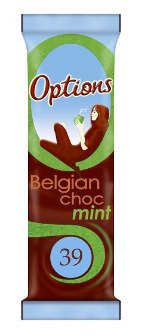
Well, I managed to satisfy my sweet tooth with just 39 calories. You can buy sachets of Options Hot Chocolate, I went for the delicious Belgian Choc Mint, because i just LOVE mint chocolate – and I was secretly pretending it was a healthy peppermint tea…
2. A’kin Avocado and Calendula Conditioner, £18
This one is more for indulgence’s sake. After my sweaty training sessions with Mark, I seriously look forward to my shower. And what makes that shower even better, is this beautiful smelling conditioner from A’kin.
This conditioner is enriched with Organic avocado oil, Jojoba oil, calendula and wheat protein. Plus, all A’kin shampoo and conditioner is silicone free. This avoids the build of of plastic coating on hair when used over time.
3. Al!ve Magnesium Plus Energising Body Gel Lotion, £5
Dare I mention magnesium again, or is someone going to write in and tell me to stop banging on about it? Well if you want to read about why magnesium is so important, have a read of my other two diary entries.
Anyway, the reason I am obsessing over this particular product is because it’s gel substance is easily absorbed into the skin, it doesn’t leave you feeling all greasy when you are trying to put your jeans or your tights on.
Plus, because of the chemical structure of magnesium, it is actually well absorbed through the skin. Therefore, this gel can help to relieve stress and stiff muscles, improve joint health and circulation, plus it can aid nutrient absorption and of course skin hydration.
Results at the end of week three
| Before | End of week one | End of week two | End of week three | ||
| Weight kg | 68.9 | 67.4 | 66.3 | 65.5 | |
| Body fat % | 27.0 | 25.8 | 24.2 | 24.6 | |
| Hips cm | 107 | 107 | 104 | 105 | |
| Waist cm | 77 | 75 | 74 | 73 | |
| Stomach cm | 90 | 88 | 86 | 86 | |
| Thighs cm
Overall weight loss kg |
56
N/A |
55
1.5 |
54
2.6 |
55
3.4 |
So my measurements this week have done something strange, I have still lost weight, taking my total weight loss to 3.4kgs (that’s half a stone), but my body fat percentage has risen by 0.4 per cent and a few of my measurements have also gone up.
Mark assures me this is nothing to worry about, in fact he said ‘I wouldn’t even call this a plateau’. Mark suggested that it could be water retention or time of the month hormones. Who knows? I guess I will have to see what the measurements say next week.
I won’t let any of it demotivate me though and I am certainly noticing a difference in my clothes. On to week four, wish me luck!
Come back every week to read Olivia’s week by week diary of her weight loss transformation with Mark Stanton and Emma Bardwell at Transition Zone.
For a free 15 minute introductory call to talk about goals, symptoms and expectations click here.
Follow Transition Zone on Instagram or see their website and latest newsletter for more information.
Exclusive networking event – Health To Wealth
If you’ve always wanted to make money from your healthy passion, Healthista’s upcoming Health To Wealth event is your chance to learn how to grow your business and network with people that can help.
Healthista have teamed up with luxury hotel brand Pullman Hotels & Resorts to launch a new wellness entrepreneurship-focused initiative and event – Health To Wealth – to help budding start-ups bring their businesses to life.
This is your chance to network with top wellbeing business experts and media.
The live event will see Healthista readers, consumers, influencers, media and businesspeople alike, come together to share and learn.
During the event, selected early-stage health businesses and ideas will be put to the test Dragon’s Den-style before a panel of industry experts including BBC Dragon – and Healthista investor – Touker Suleyman.
When: June 13th, 2019
Where: The Shaw Theatre, Pullman London St Pancras, 100-110 Euston Road, King’s Cross, London, NW1 2AJ
Time: 6.00pm-9.30pm
Tickets: £15 from this link. Entry price includes a wellbeing goodie bag worth over £50.
On the night
Successful entrepreneurs from all areas of wellness including nutrition, fitness, and fashion will take part in a panel discussion focused on sharing their experience, tips and tricks for starting and growing a business in the wellness space.
This will be followed by a Dragon’s Den-style format, inviting up-and-coming wellness entrepreneurs to pitch for support to further the success of their own businesses.
The Health To Wealth entrepreneur’s panel includes:
Touker Suleyman, BBC Dragon, multi-millionaire behind brands including Finery, Ghost and Hawes & Curtis and Healthista investor.
Emlyn Brown, Vice-President Well-Being, Luxury and Premium Brands at Accor Hotels.
Ashley Verma, founder of London’s barre fitness studio DEFINE London.
Anna Magee, Healthista Editor and CEO and multi-award winning health journalist.
Charing the panel will be Anni Hood, co-founder and chief executive at Well Intelligence – a research, insights and market evidence platform aimed at helping wellbeing businesses grow.
Tickets to join the audience to learn from the successes and hurdles overcome by the panel of speakers are £15 per person and available to purchase from here.
More Healthista Content:
What really works for teenage acne
‘Why I wrote a feminist version of The Little Mermaid’
8 ways walking can help depression and anxiety – the psychotherapist’s guide
Meet a TV Dragon and grow your business
When you get serious about weight loss, these are 3 things you need to give up
7 lessons I learned growing my business from bedroom to boardroom
9 steps to creating a retreat at home
Like this article? Sign up to our newsletter to get more articles like this delivered straight to your inbox.



